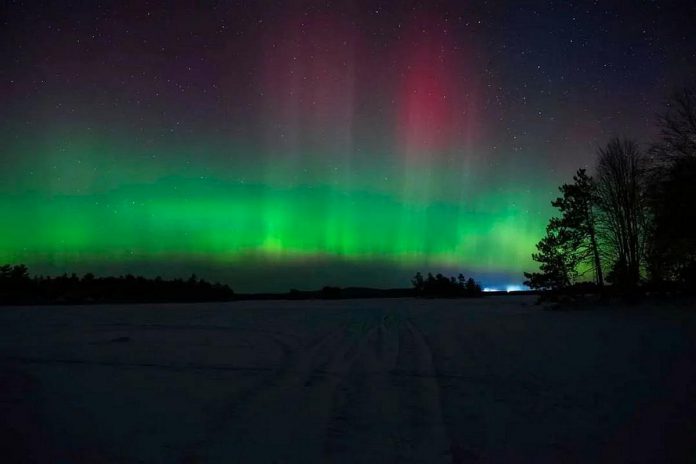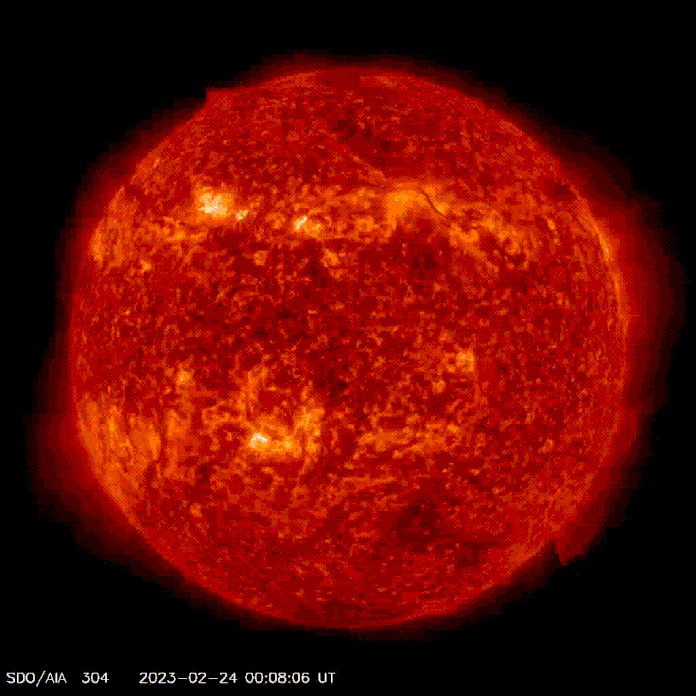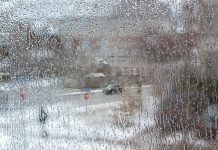
Photographers across the Kawartha region captured stunning photos of the northern lights (aurora borealis) earlier this week, and the phenomenon may be visible again over the weekend.
The spectacular display of dancing waves of coloured light is caused by the solar wind — highly energetic charged particles emitted by the Sun’s corona — that collides with the Earth’s magnetic field at 72 million kilometres per hour. The magnetic field acts as a shield, deflecting most of the particles towards the poles, where they interact with molecules in the upper atmosphere and cause it to fluoresce.
Most of the time, the aurora appears as a green ethereal glow and is only visible at higher latitudes closer to the poles. While auroras can be seen in the northern greater Kawarthas region, several significant solar events in late February made them visible even further south.
These events produced a stronger solar wind that essentially dragged the Earth’s magnetic field further away from the poles, making the northern lights visible further south and filling the sky with reds and purples as the solar wind reacted with nitrogen in the upper atmosphere.
One of these events occurred on February 24, when there was a coronal mass ejection associated with an M3.7 class solar flare from an area of the Sun known as sunspot region AR3234.
A coronal mass ejection is an explosive expulsion of billions of tons of plasma from the Sun’s corona that carries an embedded magnetic field. They are often associated with solar flares, whose strength is rated by class, with the smallest ones A-class (near background levels) followed by B, C, M and X. Each letter represents a 10-fold increase in energy output. M class flares can cause brief radio blackouts that affect Earth’s polar regions and minor radiation storms, and X class flares can trigger planet-wide radio blackouts and long-lasting radiation storms.

If a coronal mass ejection is directed towards Earth, it can reach our planet in as little as 15 to 18 hours (slower ones can take several days to arrive). The February 24th one reached Earth on February 27th and produced a display of northern lights across Alaska, Canada, northern Europe, and even the northernmost U.S. states.
On February 28, sunspot region AR3234 produced another coronal mass ejection associated with an M8.6 solar flare — which is only a few percentage points below an X class flare. The M8.6 flare emitted a burst of X-rays that ionized the top of Earth’s atmosphere, causing a shortwave radio blackout over North America and producing auroras as far south as the U.S. state of Colorado.
Although sunspot region AR3234 is about to be rotated off the Earth-facing side of the Sun, the slow-moving coronal mass ejection from February 28 may give Earth a glancing blow on Saturday (March 4) and produce more auroras.
If the coronal mass ejection does hit Earth on Saturday, photographers in the Kawarthas region may have another chance to capture the northern lights. Environment Canada’s current forecast is calling for cloudy periods with a chance of flurries on Saturday night, and clear skies on Sunday night.
Although a smartphone camera can capture the lights, a DSLR camera will give you the best results. Morgan Spence of BBC Scotland has a few tips for photographing the northern lights:
- Switch your camera to manual mode to give you full control of the settings
- Mount your camera on a tripod
- Set your shutter speed between one second and 15 seconds (i the aurora is shimmering quickly, lower the shutter speed)
- Set the aperture (f-stop) as wide as possible — f/2.8 or lower — to ensure plenty of light is hitting the camera’s sensor
- Try varying the ISO between 800 and 3,200, depending on the conditions
- Switch from autofocus to manual focus and set it to “infinity” (look for the “8” symbol)
About last night.
As I sat back and watched the Aurora gain intensity over Russia, Iceland, Greenland and then over…Posted by Dana McMullen's Imageroom on Monday, February 27, 2023


























